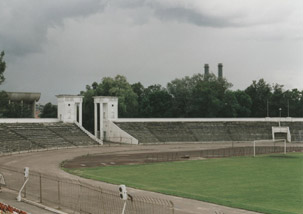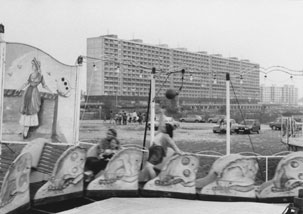 |
|
 |
|
 |
|
 |
|
 |
|
 |
|
| Josef Dabernig Film, Photograph, Text, Object, Construction 16 September – 5 November 2006 |
|||||
|
|||||
|
Opening Exhibition to be opened
by Dr. Christoph Mader, Office of the Tyrolean Provincial Government,
Department for Culture |
||||
| Josef
Dabernig
has attained international acclaim with his installations and films
(Manifesta 3, 2000 and Venice Biennale 2003). This exhibition and
catalogue, produced in collaboration with the Galerie für
zeitgenössiche Kunst in Leipzig and the Bunkier Sztuki in
Cracow,
show a selected cross-section of his work. Dabernig’s oeuvre
is
characterized by his broad conceptual interest in ordering systems. These systems include mathematics, urban planning, architecture, standardized materials, theoretical or scientific texts, but also normed behaviour. Dabernig incorporates parameters from the outside world in his concept using them as variable factors in a given work or entire project. Early examples of processed and newly formulated systems of order are Dabernig’s copying works created from 1977 on. Here he meticulously copied entire books by hand. He copied for example all 176 pages of F.X. Mayr’s “Schönheit und Verdauung” (“Beauty and Digestion”), a diet book published in 1920. Dabernig considered this act as a strange process of reversal, as a sort of “abreaction” following years of discipline in a boarding school. He also copied city guides or a chapter from Vittorio Gregotti’s “Il territorio dell’architettura”, gas bills or tickets for football games. In these works the artist figured as both a medium and a player in a self-referential way. Dabernig also appears as an actor in his films. Two of them, “Lancia Thema” (2005) and “Rosa Coeli” (2003) are shown in the exhibition. The protagonists in Dabernig’s structurally precisely conceived films move in fragmented plots whose outcome remains open. Dabernig stages, not without irony, orders; the parameters of these orders are neither clear nor “reasonable” and things are getting out of joint. The films “Wisla” (1996), “Timau” (with Markus Scherer, 1998), “Jogging” (2000), “WARS” (2001), “automatic” (with G.R.A.M., 2002), “Parking” (2003), “Rosa coeli” (2003) and “Lancia Thema” (2005) will be shown at the cinema Cinematograph in Innsbruck on 8 October 2006. In Dabernig’s work photography plays a special role. For the past two decades he has been putting together a comprehensive archive from which he selects his photographic conceptual works. These photographs, many of them architectural motifs of modernity, stadiums, apartment buildings, details of facades or interiors as well as street shots, were created with a targeted gaze on trips or while studying abroad. Josef Dabernig would later “elaborate and semantically condense these photographs into a story or scene”. (Christian Kravagna) Since the beginning of his artistic career Dabernig has also done sculptural work. These pieces are space-specific objects usually created out of found material for which he developed aesthetic solutions grounded on selected mathematical rules. At the Galerie im Taxispalais different variants of grid-like metal structures will be shown, entering into a dialogue with the given spatial setting. Dabernig designs his constructions on a similar principle – both architectural art-in-architecture projects as well as interior space design. One example is the reading room and lounge at the MUMOK in Vienna which he created in 2002, or the exhibition architecture for the “Individual Systems” project curated by Igor Zabel at the 2003 Biennale in Venice. These constructions will be presented as sketches of perspectives and photographs at the Galerie im Taxispalais. The catalogue shows how Dabernig’s conceptual method, with all its ramifications, informs his work. The artist designed the catalogue according to his own principles seeing it also as part of his artistic work. Josef Dabernig was born in Lienz in 1956. He lives and works in Vienna. |
|||||
|
Catalog Cooperation
Partners |
|||||
|



